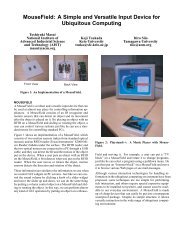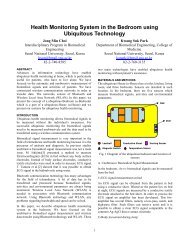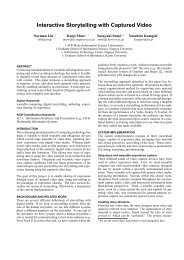though Tui ( , ) / Toi ( ) , in which To( i ) is the averageattention duration of historical users on item i , and Tui ( , )is the attention duration of user u .Combining the user rating and the user attentionduration, we define the experience of user u on item iasTui ( , )Eui ( , ) Impactui ( , ) . (6)To()iBased on equation (6), we introduce the definition ofindividual user experience asTui ( , )Eu ( ) Eui ( , ) Impactui ( , ) . (7)To()iiA( u) iA( u)Quantitative Evaluation of Group User ExperienceAs we have mentioned, group user experience include notonly each member’s direct experience but also indirectexperience. In other words, group user experience is thesum of each member’s direct experience and indirectexperience. At the same time, different types of user groupswould result in different kinds of evaluation models ofgroup user experience. In this section, we will discuss thequantitative evaluation of group user experience accordingto the four different types of user groups.Case 1: Tightly Coupled Homogeneous GroupsFor a tightly coupled homogeneous group, on the one hand,the relationships among members are equal and themembers have the same privileges. This means that eachmember’s direct experience has the same weight in theevaluation model of group user experience. On the otherhand, members are close to each other and theintercommunication plays an important part, so the indirectexperience should be taken into account in forming groupuser experience. We define the quantitative evaluationmodel of group user experience for this kind of user groupsasEG ( ) [ Eu ( ) Eu( )] , (8)withuGTi () E( u) ( u) Impact( u, i), and ( u)To()iiA( G)iA( u)( 0 ( u) 1 ) is the receptivity of user u whencommunicating with the other members; Impact( u, i) isthe revised average rating for item i given by groupmembers who have visited item i ; Ti ( ) is the averageattention duration of item i given by group members whohave visited item i .Case 2: Loosely Coupled Homogeneous GroupsSimilarly to the tightly coupled homogenous group, on theone hand, members of a loosely coupled homogenous grouphave the same privileges and each member’s directexperience has the same weight in the evaluation model. Onthe other hand, members of this kind of groups areestranged to each other and the intercommunication can beignored. Therefore, we define the quantitative evaluationmodel of group user experience for this kind of user groupsasEG ( ) Eu ( ). (9)uGCase 3: Tightly Coupled Heterogeneous GroupsFor a tightly coupled heterogeneous group, on the one hand,the relationships among members are unequal and membershave different privileges. This means that each member’sexperience has different weight in the evaluation model. Onthe other hand, members are familiar to each other and theintercommunication plays an important part, so the indirectexperience should be taken into account. We define thequantitative evaluation model of group user experience forthis kind of user groups asEG ( ) { ( u) [ Eu ( ) Eu( )]} . (10)uGIn equation (10), ( u)( 0 ( u) 1 ) is theinfluence of user u to the overall group user experience.Case 4: Loosely Coupled Heterogeneous GroupsSimilarly, the evaluation model of group user experience forloosely coupled heterogeneous groups is defined asE( G) [ ( u) E( u)]. (11)uGIt must be pointed out that although group members oftightly coupled user groups are familiar to each other,generally speaking, during their intercommunication not allthe items are discussed, maybe only those most impressingand interesting items are involved. This means that theindirect experience a user acquired is usually less thanEu ( ) as defined in equations (8) and (10). Therefore, weintroduce a parameter (0 1 ) to describe thediscussion lever of a user group, where relates to thefamiliarity extent of group members. Similarly, for aloosely coupled user group, although its members areestranged to each other, there still is intercommunicationand the indirect experience should been taken into account.As a consequence, the evaluation model of group userexperience for two types of homogenous user groups can bedefined in a uniform format asE( G) [ E( u) E( u)] . (12)uGSimilarly, the evaluation model of group userexperience for two types of heterogeneous user groups canbe defined in a uniform format asEG ( ) { ( u) [ Eu ( ) Eu( )]} . (13)uGAccording to equations (8)-(13), we find thatquantitative evaluation models of group user experience fordifferent types of user groups have a similar format. In fact,equation (12) is a special modality of equation (13), wherethe value of ( u)is 1. Therefore, the quantitativeevaluation models of group user experience for fourdifferent categories of user groups can be expressed in auniform format using equation (13).42
During the above discussion, user groups are dividedinto four categories, and the quantitative evaluation modelof group user experience for each kind of group has beenstudied separately. However, an actual user group could bemuch more complex, and a single user group may includeseveral independent and distinct subgroups, for instance, atourist group may comprise several subgroups of family andfriends. For such complex and mixed groups, the evaluationmodel will become much more complicated. Inspired by [1]in which a method for combining subgroups’ preferenceshave been proposed, we divide a mixed group into severalsubgroups and each subgroup falls into one of the fourgroup types previously defined. The experience of eachsubgroup is calculated separately and the overall experienceis acquired by aggregating each subgroup’s experience.Evaluation model of such user groups is defined asEG ( ) ( Gi) EG(i), (14)Giwith ( G i) represents the influence of subgroup G ito| Gi|the whole group and ( Gi) ( Gi) , where| G | ( G i)(0 ( G i) 1) is the weight of subgroup Gi.PROTOTYPE IMPLEMENTATION AND EXPERIMENTThe museum has proved to be an effective platform for thedemonstration and evaluation of innovative ubiquitouscomputing techniques, because of the inherent mobility ofpotential users, a wide diversity of attractive materials forpresentation, and the potentials of tourism and associatedmarkets [9].We have developed a prototype system of intelligentmuseum named iMuseum to evaluate ubiquitous computingtechniques [10]. It provides adaptive and personalizedservices, such as route navigation, exhibit recommendationand information presentation, on both the individual andgroup level. In iMuseum, the primary goal is to produce amultifaceted system that accompanies visitors andaugments their overall museum experience. In order tovalidate the evaluation model of group user experienceproposed in this paper, we designed an experiment based oniMuseum.Experimental DesignWe assume that a group of three visitors (Jim, Eva and Ben)are visiting the museum and this group may fall into one ofthree different categories, i.e. family, friends and tourists.They have visited ten exhibits (marked A-J) and theirratings have been given in Table 1, where blanks denotethat the visitor did not visit that exhibit. The ratings rangefrom 1 to 10, and a larger rating represents a betterexperience.According to group types, we have designed threedifferent scenes for our simulative visitors to mark theiroverall experience:Scene 1: Assume that Jim and Eva are husband andwife, and Ben is their child. The simulative visitors arerequired to give the perceived overall experience of thesethree persons respectively.Scene 2: Assume that Jim, Eva and Ben are peerfriends. The simulative visitors are required to give theperceived overall experience of these three personsrespectively.Scene 3: Assume that Jim, Eva and Ben are membersof a tourist group and they did not know each other beforethis tourism. The simulative visitors are required to give theperceived overall experience of these three personsrespectively.A B C D E F G H I JJim 8 7 6 7 4 3 7Eva 7 7 6 10 8 2 9Ben 9 8 8 10 6 8 9 8Table 1. Ratings by a group of three viewersExperimental Results and DiscussionAs a preliminary experiment, we did a survey on fifteensimulative visitors asking them to give their perceivedoverall experience of Jim, Eva and Ben respectivelycorresponding to the three scenes designed above. Theresult of the survey is showed in Table 2.Scene 1 Scene 2 Scene 3Jim Eva Ben Jim Eva Ben Jim Eva Ben8 9 9 8 8 9 7 8 98 9 10 7 8 8 7 8 86 7 8 6 6 7 5 6 78 8 9 8 8 8 6 7 87 7 9 6 7 8 7 7 87 7 8 6 8 8 9 8 98 8 9 7 8 9 8 9 98 9 9 7 8 9 7 8 87 7 8 7 8 9 7 7 87 8 9 7 8 9 7 8 88 9 9 7 8 9 6 7 98 9 9 7 8 8 5 7 88 8 9 8 8 8 7 8 87 8 9 7 8 9 7 6 86 7 8 7 8 9 7 7 87.4 8 8.8 7 7.8 8.5 6.8 7.4 8.224.2 23.3 22.4Table 2. Experimental data in the three scenes43
- Page 3 and 4: We would also like to extend a spec
- Page 5 and 6: ∙ USE‐03 Clinical Proof‐of‐
- Page 7 and 8: Ubiquitous Sustainability: Citizen
- Page 9 and 10: Devices that Alter Perception (DAP
- Page 11 and 12: incorporated into the body; if it d
- Page 13 and 14: vise. Beginning improvisers typical
- Page 15 and 16: Location-based Social Networking Sy
- Page 17 and 18: PrivacyWith any social networking a
- Page 19 and 20: BOXED EGO INSTALLATIONA pair of cam
- Page 21 and 22: the natural egocentric visuospatial
- Page 23 and 24: HUMAN SENSES AND ABSTRACT DANGERSOu
- Page 25 and 26: Gesture recognition as ubiquitous i
- Page 27 and 28: een developed to overcome this. For
- Page 29 and 30: 16. Myvu Corporation. Myvu Crystal.
- Page 31 and 32: especially in the fields of Ambient
- Page 33 and 34: 14. G. Riva (Editor), F. Vatalaro (
- Page 35 and 36: system, reflex arcs, and even muscl
- Page 37 and 38: 5. R. Cytowic. Synesthesia: Phenome
- Page 39 and 40: RELATED WORKLet us consider the loc
- Page 41 and 42: (a) Actual traces.(a) Actual traces
- Page 43 and 44: Figure 2. Schematic picture of the
- Page 45 and 46: notion of partial/total immersion w
- Page 47 and 48: A Quantitative Evaluation Model of
- Page 49: a group of users. We, therefore, in
- Page 53 and 54: Usability Study of Indoor Mobile Na
- Page 56 and 57: 11%3%0%0%30%19%5%3%0%11%56%Notifyed
- Page 58 and 59: CONCLUSIONFor this study, we have d
- Page 60 and 61: are suited to provide sufficient cl
- Page 62 and 63: attention to your blood pressure re
- Page 64 and 65: invested in final development and c
- Page 66 and 67: 4. rhythms - the highly predictable
- Page 68 and 69: technologies, especially their coll
- Page 70 and 71: Situvis: Visualising Multivariate C
- Page 72 and 73: all. A user selecting a range withi
- Page 74 and 75: constraints to include traces that
- Page 76 and 77: Simulation Framework in Second Life
- Page 78 and 79: VirtualEmitterEstimatedPositionVirt
- Page 80 and 81: odies) then our approach would faci
- Page 82 and 83: Design and Integration Principles f
- Page 84 and 85: asis for interaction, it focuses on
- Page 86 and 87: to support POST and GET messages as
- Page 88 and 89: senor node’s functionalities in a
- Page 90 and 91: service model and provide paradigms
- Page 92 and 93: Virtualization of resources will fa
- Page 94 and 95: Figure 3. Heating and lighting cont
- Page 96 and 97: sat down at the same time” can be
- Page 98 and 99: 10!; !< !=!"#$%&’"()%* +$(%,-’#
- Page 100 and 101:
posite event operators such as conj
- Page 102 and 103:
objects? If these particles were sm
- Page 104 and 105:
Over-the-air-programmingOTAP (Over-
- Page 106 and 107:
Randomised Collaborative Transmissi
- Page 108 and 109:
Figure 2. Illustration of periodic
- Page 110 and 111:
Figure 3. Illustration of the recei
- Page 112 and 113:
Experimental Wired Co-operation Arc
- Page 114 and 115:
The structure of network is matrix
- Page 116 and 117:
Altera Quartus II v7.2SP3 FPGA soft
- Page 118 and 119:
Using smart objects as the building
- Page 120 and 121:
To the ambient ecology concepts des
- Page 122 and 123:
event. A more complicated approach
- Page 124 and 125:
Multi-Tracker: Interactive Smart Ob
- Page 126 and 127:
interfacing with whole space, but c
- Page 128 and 129:
operate interactions by many partic
- Page 130 and 131:
An Augmented Book and Its Applicati
- Page 132 and 133:
its withy material. So, the movemen
- Page 134 and 135:
Table 1. The Performance of Page Fl
- Page 136 and 137:
Ambient Information SystemsWilliam
- Page 138 and 139:
We, too, believe there is a certain
- Page 140 and 141:
management system and forwarded to
- Page 142 and 143:
CONCLUSIONWe have presented the des
- Page 144 and 145:
Ambient interface design for a Mobi
- Page 146 and 147:
as ‘sensitive’ and filtered awa
- Page 148 and 149:
Ambient Life: Interrupted Permanent
- Page 150 and 151:
The log files revealed the actual r
- Page 152 and 153:
Stay-in-touch: a system for ambient
- Page 154 and 155:
Figure 1. The Stay-in-touch display
- Page 156 and 157:
User Generated Ambient PresenceGerm
- Page 158 and 159:
Figure 3: Cross-platform system tra
- Page 160 and 161:
The Invisible Display - Design Stra
- Page 162 and 163:
On a more general level Mimikry cre
- Page 164 and 165:
Rand in fact few examples of public
- Page 166 and 167:
Ambient Displays in Academic Settin
- Page 168 and 169:
usefulProfiles 22 (37%)Time and dat
- Page 170 and 171:
UTILIZE THE POTENTIAL TO FULLEST: D
- Page 172 and 173:
A notification system for a landmin
- Page 174 and 175:
As for the investigation phase, whe
- Page 176 and 177:
Ubiquitous Sustainability: Citizen
- Page 178 and 179:
Live Sustainability: A System for P
- Page 180 and 181:
(a) (b) (c)Figure 3. Screenshot for
- Page 182 and 183:
Motivating Sustainable BehaviorIan
- Page 184 and 185:
dialog with policy makers and servi
- Page 186 and 187:
5. Fogg, B. J. (2002). “Persuasiv
- Page 188 and 189:
on mode of transportation such as t
- Page 190 and 191:
In order to be useful, PET requires
- Page 192 and 193:
provides a relevant description and
- Page 194 and 195:
Star, L. S., The Ethnography of Inf
- Page 196 and 197:
door environment, the accuracy of G
- Page 198 and 199:
Figure 5. Variations of “Parasiti
- Page 200 and 201:
can view where it has been, who ans
- Page 202 and 203:
Nevermind UbiquityJeff BurkeCenter
- Page 204 and 205:
innovating within existing capacity
- Page 206 and 207:
Since the Brundlandt report a serie
- Page 208 and 209:
our current research in mobile gami
- Page 210 and 211:
conceive only of human-computer int
- Page 212 and 213:
human behaviour will encounter. The
- Page 214 and 215:
mental models of the world are test
- Page 216 and 217:
alternative, the place that could h
- Page 218 and 219:
elow the mode button indicate the c
- Page 220 and 221:
212
- Page 222 and 223:
digital collection of features to a
- Page 224 and 225:
immediately followed by a subset of
- Page 226 and 227:
forecast the future accesses to tho
- Page 228 and 229:
Enhanced and Continuously Connected
- Page 230 and 231:
than two application windows execut
- Page 232 and 233:
Secure and Dynamic Coordination ofH
- Page 234 and 235:
AudioProducer/ConsumerVideoConsumer
- Page 236 and 237:
228
- Page 238 and 239:
MotivationsMotivations occurred on
- Page 240:
Kray Christian ··········






